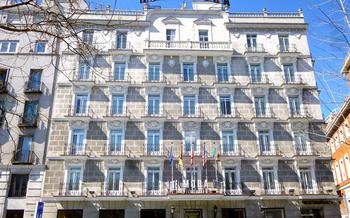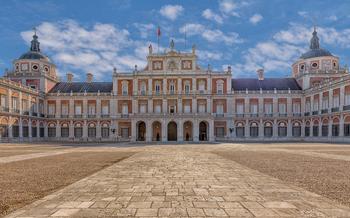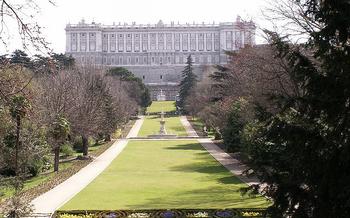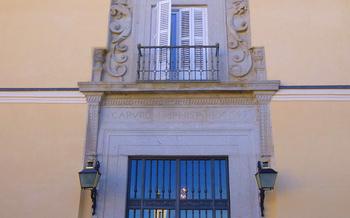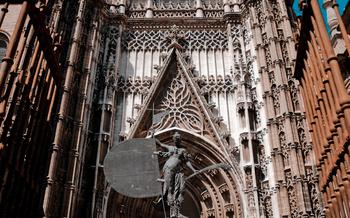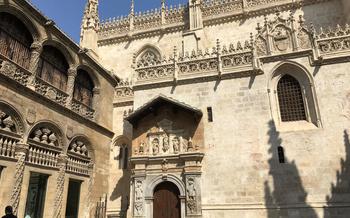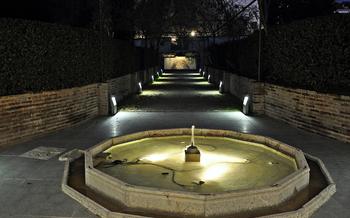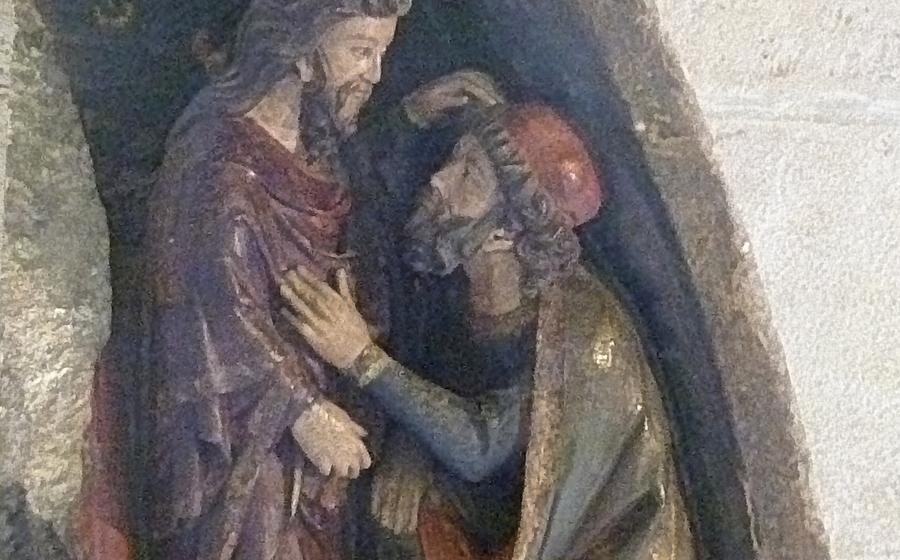
Parque de la Quinta
- A Stroll Through History
- Nature's Embrace
- The Royal Palace: A Glimpse into the Past
- The Orangery: A Touch of Exoticism
- The Labyrinth: A Journey of Discovery
- The Aviary: A Symphony of Feathers
- Insider Tip: The Best Time to Visit the Aviary for Birdwatching
- The Children's Playground: A Realm of Fun
- The Café: A Place to Relax and Refresh
- The Park's Environmental Initiatives
- The Park's Accessibility
- The Park's Opening Hours and Admission
- The Park's Location and Transportation
- Insider Tip: Unveiling the Secret Garden
A Stroll Through History
The Parque de la Quinta, a former royal estate transformed into a captivating urban oasis, beckons visitors to embark on a journey through time. Its rich history is intertwined with the monarchy, leaving an indelible mark on the city of Burgos.
Established in the 14th century as a hunting ground for the royal family, the park underwent a remarkable transformation in the 19th century. Under the patronage of Queen Isabel II, the estate was lovingly redesigned into a romantic English-style garden, complete with a stunning palace and an array of exotic plants.
Strolling through the park, visitors can admire the architectural remnants of its regal past. The Royal Palace, a striking example of Neoclassical elegance, stands as a testament to the park's former grandeur. Intricate sculptures, ornate fountains, and manicured hedges transport visitors back to an era of opulence and refinement.
During my own visit to the park, I had the serendipitous opportunity to meet a local historian, Señor García, who shared fascinating anecdotes about the park's royal connections. He recounted tales of lavish parties, hunting expeditions, and the everyday lives of the monarchs who once graced these grounds.
Nature's Embrace
The Parque de la Quinta is a haven for nature enthusiasts, boasting a diverse array of flora and fauna that contributes to its ecological richness. As you stroll through the park, you'll be greeted by an enchanting tapestry of colors and textures, with over 400 species of plants adorning the landscape. Among these botanical wonders, you'll find majestic trees that have stood tall for centuries, each with its own story to tell.
One of the park's highlights is the venerable oak tree, a symbol of strength and resilience. Its gnarled branches reach towards the sky, providing a home for countless birds and small creatures. The park's gardeners have carefully preserved these ancient trees, ensuring their continued presence for generations to come.
Beyond the trees, the park is home to a myriad of other plant species, including vibrant flower beds, lush shrubs, and aromatic herbs. Each season brings its own unique charm, with spring showcasing a riot of colors as flowers bloom in abundance. Summer offers a verdant paradise, with the park's foliage providing a cool respite from the scorching sun. Autumn paints the landscape in hues of gold and crimson, as the leaves prepare for their seasonal transformation. Winter, though quieter, still holds its own magic, with frost-kissed leaves and the occasional snow-covered branch adding a touch of enchantment to the park's scenery.
The park's diverse flora provides sustenance and shelter for a variety of animal species, contributing to its rich biodiversity. Birdsong fills the air as colorful feathered friends flit through the trees, their melodies creating a harmonious soundtrack to your walk. Squirrels scurry along the branches, their playful antics adding a touch of whimsy to the park's ambiance. And if you're lucky, you might even catch a glimpse of the park's resident rabbits, hopping through the undergrowth with their fluffy tails bobbing behind them.
More than just a beautiful green space, the Parque de la Quinta serves as a vital urban oasis, providing a much-needed escape from the hustle and bustle of city life. Its tranquil atmosphere and abundance of nature offer visitors a chance to reconnect with themselves and the natural world, fostering a sense of peace and rejuvenation. Whether you're seeking a leisurely stroll, a meditative moment, or simply a chance to admire the beauty of nature, the Parque de la Quinta has something for everyone to enjoy.
The Royal Palace: A Glimpse into the Past
The Royal Palace within the Parque de la Quinta stands as a testament to the site's regal history. Built in the 19th century, the palace is a fine example of neoclassical architecture, with its elegant façade adorned with intricate carvings and columns. Inside, visitors are greeted by a grand entrance hall, which leads to a series of opulent rooms. The palace's interior boasts a collection of exquisite furniture, tapestries, and artwork, offering a glimpse into the lives of the Spanish royalty who once resided here.
One of the highlights of the palace is the Throne Room, where the Spanish monarchs would receive their guests and conduct official ceremonies. The room is adorned with a magnificent throne, intricate chandeliers, and a frescoed ceiling that depicts scenes from Spanish history. Another notable feature of the palace is the Royal Chapel, with its ornate altar and stained-glass windows.
Today, the Royal Palace serves as a museum, offering visitors the opportunity to explore its rich history and admire its architectural and artistic treasures. The palace also hosts temporary exhibitions, allowing visitors to delve deeper into various aspects of Spanish culture and heritage.
Interesting Fact:
Beneath the Royal Palace lies a secret passageway that was once used by the Spanish monarchs to discreetly travel between the palace and the city of Burgos. This hidden tunnel provided a safe and private means of transport, allowing the royals to move about without being seen by the public.
The Orangery: A Touch of Exoticism
Amidst the lush greenery of the Parque de la Quinta, the Orangery stands as a testament to the park's rich history and exotic allure. Built in the 18th century, this elegant structure was originally designed to house the royal family's collection of citrus trees, which were highly prized for their rarity and flavor.
The Orangery's architectural features are a blend of classical and baroque styles, with its symmetrical facade, arched windows, and intricate ironwork. Inside, the spacious hall is filled with rows of terracotta pots, each containing a different variety of citrus tree. The air is heavy with the sweet scent of oranges, lemons, and grapefruits, creating a truly sensory experience.
In addition to its historical significance, the Orangery has been transformed into a vibrant cultural venue. It regularly hosts concerts, exhibitions, and other events, adding to the park's diverse offerings. The Orangery's unique atmosphere and stunning backdrop make it a popular choice for weddings and special occasions.
Fun Fact: The Orangery has played a significant role in promoting the arts and culture in Burgos. It has hosted performances by renowned musicians, artists, and theater groups, contributing to the city's rich cultural landscape.
The Labyrinth: A Journey of Discovery
Amidst the verdant expanse of the Parque de la Quinta, a hidden gem awaits those who seek adventure and introspection: the labyrinth. Constructed in the 18th century as a symbol of life's intricate journey, this enigmatic maze invites visitors to embark on a physical and metaphorical quest for self-discovery.
With its towering hedges forming a verdant labyrinth, the labyrinth presents a challenge that is both exhilarating and thought-provoking. As you navigate the winding paths, you'll find yourself confronted with choices and dead ends, mirroring the complexities of life's own twists and turns. The challenge lies not only in finding your way through the maze but also in embracing the process, learning from your missteps, and ultimately discovering a deeper understanding of yourself.
Beyond its practical function, the labyrinth holds symbolic significance, representing the journey of life with its inherent uncertainties and rewards. It encourages introspection and self-reflection, inviting visitors to ponder their own paths and the choices they make along the way. Whether you seek a unique adventure or a profound experience of self-discovery, the labyrinth in the Parque de la Quinta offers a captivating journey that will leave an indelible mark on your memory.
Anecdote: Getting lost in the labyrinth and finding an unexpected surprise
During my initial visit to the Parque de la Quinta, I couldn't resist the allure of the labyrinth. As I ventured into its depths, I quickly realized that I had underestimated its complexity. The paths twisted and turned, leading me into dead ends and circles. Frustration began to creep in as I retraced my steps, feeling disoriented and lost.
Just when I was about to give up, I stumbled upon an unexpected sight—a small, secluded garden hidden within the labyrinth's heart. This secret oasis, with its vibrant flowers and tranquil fountain, was a welcome respite from the maze's challenges. I sat down on a bench and took a moment to appreciate the unexpected beauty I had discovered through my perseverance.
That experience taught me that sometimes, getting lost can lead to unexpected rewards. Just as in life, the most fulfilling journeys are often the ones that take us down unfamiliar paths and challenge our preconceptions. The labyrinth in the Parque de la Quinta not only tested my sense of direction but also reminded me that even in moments of confusion and uncertainty, there is always the potential for serendipitous discoveries.
The Aviary: A Symphony of Feathers
The Parque de la Quinta is home to a delightful aviary that alberga a diverse array of bird species from around the world, each contributing to a vibrant symphony of feathers and songs. Among the feathered residents, visitors can spot the resplendent Blue-and-Yellow Macaw, with its striking cobalt and gold plumage, the elegant Scarlet Ibis, known for its vivid crimson feathers, and the playful African Grey Parrot, renowned for its intelligence and ability to mimic human speech. These magnificent creatures captivate visitors with their colorful displays and enchanting melodies, creating a truly immersive experience.
Beyond showcasing the beauty and diversity of the avian world, the aviary plays a crucial role in conservation efforts. Dedicated staff members are committed to providing the best possible care for the birds, ensuring their well-being and creating a nurturing environment that mimics their natural habitats. Furthermore, the aviary actively participates in breeding programs aimed at preserving endangered species, contributing to the global fight against biodiversity loss.
Visitors to the aviary can not only admire the birds' beauty but also learn about their unique behaviors, adaptations, and conservation status through interactive exhibits and informative signage. The aviary serves as an educational hub, fostering a greater appreciation for the importance of bird conservation and the delicate balance of ecosystems.
Insider Tip: The Best Time to Visit the Aviary for Birdwatching
To fully immerse yourself in the avian symphony of the Parque de la Quinta, plan your visit to the aviary carefully. Early mornings or late afternoons, when the sun is less intense, are ideal times to observe the birds at their most active. The birds are often more vocal and engaged during these periods, providing visitors with an unforgettable opportunity to witness their natural behaviors and interactions. Additionally, the cooler temperatures make for a more comfortable experience for both the birds and visitors alike.
The Children's Playground: A Realm of Fun
Amidst the tranquil gardens and historic buildings of the Parque de la Quinta, a vibrant realm unfolds—the children's playground. This enchanting space is a haven for young explorers, offering a kaleidoscope of play areas and activities designed to ignite their imaginations and foster their development.
Safety and inclusivity are paramount in this whimsical realm. The playground's soft rubberized surfaces, carefully designed equipment, and accessible features ensure that children of all abilities can join in the fun. The play areas are thoughtfully planned to cater to different age groups, with dedicated sections for toddlers and older children.
In this realm of boundless energy, children can swing high into the sky, slide down colorful chutes, climb intricate structures, and engage in imaginative play. The playground also features interactive elements such as water play areas and sandboxes, providing endless opportunities for exploration and sensory stimulation.
The children's playground in the Parque de la Quinta is not merely a place for recreation; it is a space where children can socialize, learn, and grow. As they navigate the playground's challenges, they develop physical skills, problem-solving abilities, and social interactions. The playground fosters a sense of community among the young visitors, encouraging them to make new friends and build lasting memories.
Watching my child's eyes light up with delight as she explored the playground's wonders was a priceless moment. The laughter, the squeals of joy, and the camaraderie she shared with other children created a magical atmosphere that transported me back to my own childhood adventures.
In the Parque de la Quinta's children's playground, the spirit of play and imagination reigns supreme, offering young visitors an unforgettable experience that will stay with them long after they leave this enchanting realm.
The Café: A Place to Relax and Refresh
Amidst the verdant expanse of the Parque de la Quinta, visitors can find a charming oasis where they can unwind and replenish their spirits. The park's café, with its inviting ambiance and welcoming outdoor seating, offers a delightful respite from the bustle of the city. Indulge in a delectable array of Spanish and international culinary delights, savoring the flavors of the region while immersing yourself in the park's tranquil atmosphere.
The café serves as a convivial gathering place for locals and tourists alike, fostering a sense of community and camaraderie. Engage in lively conversations, share travel tales, or simply bask in the serenity of the surroundings. As you sip on a refreshing beverage or savor a delectable pastry, let the park's enchanting ambiance work its magic, leaving you feeling rejuvenated and refreshed.
One unique aspect of the café is its commitment to sustainability. The menu proudly features locally sourced ingredients, supporting the local economy and reducing the park's carbon footprint. From farm-to-table dishes to organic beverages, the café's offerings are not only delicious but also environmentally conscious.
Whether you're seeking a quick bite, a leisurely lunch, or an afternoon tea break, the café at the Parque de la Quinta is the perfect destination. Immerse yourself in the park's natural beauty, savor the flavors of the region, and embrace the café's warm hospitality.
The Park's Environmental Initiatives
The Parque de la Quinta is a shining example of environmental stewardship and sustainability. The park's management team has implemented a range of initiatives to reduce the park's ecological footprint and promote conservation. These initiatives include recycling and composting programs, water conservation measures, and the use of renewable energy sources. The park also plays a vital role in raising awareness about environmental issues among visitors. Through educational programs, signage, and events, the park encourages visitors to adopt more sustainable practices in their daily lives. By showcasing how a large urban park can operate in harmony with the environment, the Parque de la Quinta serves as a model for other green spaces around the world.
Anecdote:
During my visit to the park, I had the opportunity to witness a heartwarming display of the park's commitment to conservation. As I strolled through the gardens, I came across a group of volunteers releasing rehabilitated birds back into the wild. The birds, which had been injured or orphaned, had been cared for at the park's aviary until they were strong enough to return to their natural habitat. It was a truly moving experience to watch these beautiful creatures take flight and soar into the sky, knowing that they had been given a second chance thanks to the park's conservation efforts.
The Park's Accessibility
The Parque de la Quinta is committed to providing an inclusive experience for all visitors, regardless of their abilities. Wheelchair-accessible paths and facilities are available throughout the park, ensuring that everyone can enjoy its beauty and attractions. Guided tours specifically designed for visitors with disabilities are also offered, providing a comprehensive and accessible experience. The park's staff is dedicated to assisting visitors with disabilities, ensuring they have a safe and enjoyable visit.
Practical Tip: Inquiring about Accessible Parking Options
When planning your visit to the Parque de la Quinta, it's essential to inquire about accessible parking options. The park offers designated parking spaces for visitors with disabilities, located near the park's main entrance. By contacting the park's administration in advance, you can reserve an accessible parking space and ensure a hassle-free visit.
The Park's Opening Hours and Admission
The Parque de la Quinta welcomes visitors with open arms all year round, offering a tranquil oasis amidst the bustling city. Its opening hours vary slightly depending on the season, so it's advisable to check the park's website or inquire at the tourist information center for the most up-to-date information.
Generally, the park opens its gates early in the morning, allowing visitors to savor the tranquility of nature before the day's activities begin. It remains open until dusk, providing ample time to explore its many wonders at a leisurely pace.
Admission to the park is free of charge, making it an accessible and affordable destination for everyone. This generous policy ensures that visitors from all walks of life can enjoy the park's beauty and serenity without any financial constraints.
Guided tours are available for those who wish to delve deeper into the park's history, architecture, and natural wonders. These tours are conducted by knowledgeable and passionate guides who bring the park to life with their captivating stories and insights. The cost of guided tours is nominal and varies depending on the group size and the duration of the tour.
It's worth noting that the park may host special events or exhibitions from time to time, which may require a separate admission fee. These events offer a unique opportunity to experience the park in a different light and are often accompanied by food vendors, live music, and family-friendly activities.
The Park's Location and Transportation
The Parque de la Quinta is strategically situated in the heart of Burgos, making it easily accessible from various parts of the city. Its exact address is Paseo del Espolón, 8, 09003 Burgos, Spain. This central location allows visitors to explore the park while immersing themselves in the city's vibrant atmosphere and attractions.
Getting to the park is a breeze, with multiple transportation options available. Those who prefer public transportation can take advantage of the city's efficient bus network. Several bus lines, including lines 03, 04, and 07, have stops near the park, making it convenient for visitors to hop on and off.
For those who prefer the flexibility of driving, the park offers ample parking facilities in the vicinity. Visitors can find on-street parking along the park's perimeter or utilize the nearby parking garages, ensuring a hassle-free parking experience.
My personal experience with the park's location was quite serendipitous. While exploring the city's historic center, I stumbled upon a charming alleyway that led me directly to the park's entrance. This unexpected discovery added an element of surprise to my visit and made the park feel like a hidden gem waiting to be unveiled.
Insider Tip: Unveiling the Secret Garden
Amidst the sprawling expanse of the Parque de la Quinta lies a hidden gem known only to locals – the Secret Garden. Tucked away from the main paths, this secluded paradise offers a unique charm that sets it apart from the rest of the park.
The garden is a testament to the park's rich history and its former role as a royal estate. It features a charming blend of formal and informal design, with manicured flower beds, winding paths, and secluded nooks. Visitors can wander through the garden, admiring the vibrant colors and delicate fragrances of the flowers, while the sound of birdsong fills the air.
The best time to visit the Secret Garden is in the early morning, when the air is still cool and the garden is bathed in a soft golden light. As you explore its hidden corners, you'll feel like Alice in Wonderland, transported to a magical world where time stands still.
To find the Secret Garden, keep an eye out for a small, unassuming gate hidden among the trees. Once you step through the gate, you'll be transported to a tranquil oasis, a world away from the hustle and bustle of the city.

